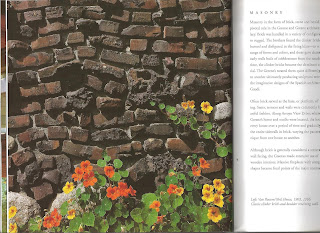.JPG) |
| I took this photo-- this house is around the corner from the Gamble House. It is one of the most perfect examaples of clinkerbrick movement and great stone placement. |
Greene and Greene Clinkerbrick and Stone Wall Photos
Last week I searched for photos of walls made of stone and clinkerbrick so we can develop some designs of our own. In order for the proper entities to receive credit for the photos posted here, I will group them from the source. There are just a few resources for Greene and Greene photos (usually books and magazines) and I can tell you (as a publisher myself of a gluten free cookbook) that quality printed materials are very expensive to produce.
In this "I want it for free on the Internet" time we live in, you need to seriously consider making some purchases from these publishers so that they can continue to produce books and magazines that you can hold in your hand. If you don't support them by buying their products, the books and magazines will go digital.
(I have not been paid to say this, it is simply a fact.)
Use the information provided here to help you get started, but make the small investment and do your part to keep printed materials available. Buy the books and subscribe to the magazines before they are gone forever. And support the retailers who bring you specialized Arts and Crafts interior elements such as light fixtures, furniture, pottery, etc.
I was surprised to find a number of Pasadena businesses that specialize in Arts and Crafts interiors closed or near closure on my last trip.
From the book Greene & Greene by Rand:
 |
| Irwin House wall and chimney |
 |
| Neil House wall (I think this is the same as the one I took at the top). |
 |
| Pratt House wall |
 |
| Blacker House posts |
From Greene & Greene Creating a Style by Makinson and Heinz:
 |
| Neil House wall detail Charles Greene house (also around the corner from Gamble House) From Style 1900 magazine: A simple low wall of stucco(or concrete?) and brick in Long Beach. Pennsylvania home, a new wall using what looks to me like regular brick. Charles Greene and an Arroyo Terrace home. Grand Avenue house with simple wall--sometimes simple is best! Gamble House backyard wall with greenery. From Along Bungalow Lines by Duchscherer and Svendsen: Los Altos new construction Outdoor stucco fireplace with tile in the Batchelder tradition, a San Diego home. From American Bungalow magazine: Mostly river rock wall topped with brick, Aidell House. And I am not sure where this photo is from: Wall on the property line behind the Gamble House that faces the Arroyo. As you can see there are many ways to approach the building of a wall in the style of Greene & Greene though it can be quite challenging to recreate the look without clinkerbrick. Our home is on a rather small city lot in a hilly area so we have more wall than any traditional G & G home. The Robinson House is faced with stucco as are other G & G homes. For our house, instead of concrete walls (and minus the brick post in the photo below) we will likely incorporate stucco walls topped with some brick and a capstone of 3" concrete like this photo: A wall in our neighborhood. (see note below about grout haze) We will incorporate posts in appropriate locations with clinkerbrick and river rocks. Since it may prove difficult to purchase very many clinkerbricks, we can't plan to use that treatment in too many places. With the amount of terraced wall we will have, landscaping will be a critical element. Grout haze is a problem around here that I need to research so we can avoid it in the future. The photo above shows it well--something white leaches from the grout and covers the brick. There are solutions you can buy to remove it. We have experienced it on the floor of a slate shower in another house and I have noticed it on exterior brick walls quite a bit around Seattle. I believe that once we removed it in our shower some sort of sealer was used to prevent it from coming back. Be sure to ask about grout haze and how to avoid it for any tile or brick project. Be sure your mason or tile setter addresses grout haze while installing (especially for interior tile and stone) because it is almost impossible to get them to come back and fix it later! |










